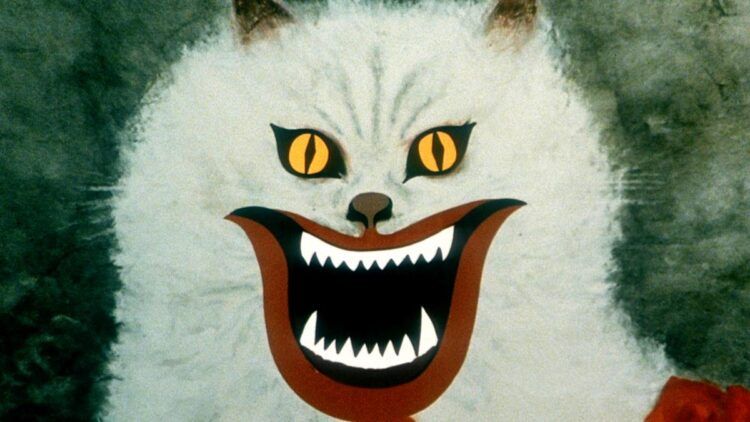Film Society x The Student: “House”
Contributing Writer Caden Stockwell ’25 reviews cult-classic horror film “House,” which played recently at Amherst Cinema. He praises its juxtaposition of childlike wonder and atomic terror.

Amherst Cinema screened Nobuhiko Obayashi’s 1977 cult classic “House” as part of its “Late Nights” series on Friday, Sept. 15. Shown in the largest of its theaters, the experimental Japanese horror-comedy-fantasy film played to a packed house, with rapturous applause and laughter heard throughout its brisk 88 minute runtime. “House” has long been one of my favorite films, and Friday’s screening was in fact my seventh time watching the masterpiece.
The film follows a group of seven Japanese schoolgirls on a trip to visit one of their aunts at her house in the countryside, where a myriad of absurd and comical terrors await as the house comes alive to eat them. Despite the film’s supernatural horror, “House” is not scary in the slightest and instead indulges in absurdity. The film is riddled with obvious green screens and exaggerated special effects, and filled with comic hijinks ranging from a girl being attacked by bedsheets to a schoolteacher suddenly turning into bananas.
The characters, each of whom is named after their one (and only) personality trait, are all delightfully predictable. The film’s protagonist is named Gorgeous because, well, she’s pretty. Her friends include Kung Fu, who — you guessed it — does kung fu; Prof, who is smart; Sweet, who is sweet; Mac, who eats a lot (a play on the word stomach); Melody, who plays music; and Fantasy, who catches on to the supernatural nature of the home early in their stay.
At first glance, it’s easy to mistake “House” for a so-bad-it’s-good film. Obayashi doesn’t care about making his effects look realistic or obeying any of the rules of filmmaking, such as continuity editing or the 180-degree rule. But a closer examination reveals a genuine masterpiece: “House” is a carefully considered and intentional film that allegorizes a child’s experience of the atomic bomb.
The story behind “House” is almost as ridiculous as the film itself. Obayashi’s background was in television advertisements, but after the success of “Jaws” in the United States, he was approached by Japanese film studio Toho and asked to make something similar. While searching for inspiration, Obayashi approached his 10-year-old daughter and asked her what she found scary. Her response influenced many of the ideas that appear in the film, such as the house eating people alive and an iconic scene in which Melody is eaten by a piano. But Obayashi, who grew up in Hiroshima and lost almost all of his childhood friends in 1945, had another goal for the film, saying that he “wanted to write a fantasy with the atomic bomb as a theme.”
The atomic bomb only explicitly appears once in the film. As the girls ride the train out to the countryside, Gorgeous tells the girls her aunt’s backstory as images of it play as an old film reel. She lost her true love during the war, and as the flashback runs, there is a two-second clip of the atomic bomb exploding, to which one of the girls remarks, “It’s like cotton candy.” This simple moment reveals one of the core contradictions highlighted by the film: something seemingly innocent wreaking incomprehensible havoc. This mirrors real life, as the bomb that dropped on Hiroshima was dubbed “Little Boy.” In the film, the physical metaphor of the bomb is a tiny, white, fluffy cat named Blanche, whose appearance is extremely reminiscent of cotton candy. She is present throughout the film, being described by the characters as a “witch cat” — every time her eyes flash green, disaster strikes. She is the “little boy,” or the cotton candy — a small, innocuous thing that causes endless disaster.
Here, we begin to develop an allegorical narrative of the film as a tale of innocence lost because of the bomb. “House” is a film of two halves — the first half shows the girls happy, childlike, full of wonder and imagination, and the second sees them all die and disintegrate in horrible ways. One of the key moments in the film comes exactly halfway through it. Gorgeous looks into a mirror and the face that reflects back at her is her aunt’s. She looks behind her but nobody is there. She looks back into the mirror, and now sees a fanged version of her own face that changes back into the face of her aunt. Generations converge. The eyes of the cat flash green. Gorgeous’s face begins to fall apart like shards of glass, revealing a burning fire underneath. Her entire body is replaced with flames. In a moment, an entire generation, old and young, is engulfed in flames.
Obayashi was only seven years old when the bomb dropped and his world was destroyed. To be a child and witness the indescribable horror of the atomic bomb is not an experience that can be conveyed literally. Instead, he thrusts us into the world of a child, seeing things through a lens of wonder and whimsy, where the scariest things that can be imagined are finger-eating pianos and killer bedsheets. And then, we watch that wonder and whimsy and innocence burn. “House” is one of the funniest, most entertaining films ever made. But when we look beneath the surface, we find something deeply tragic.





Comments ()